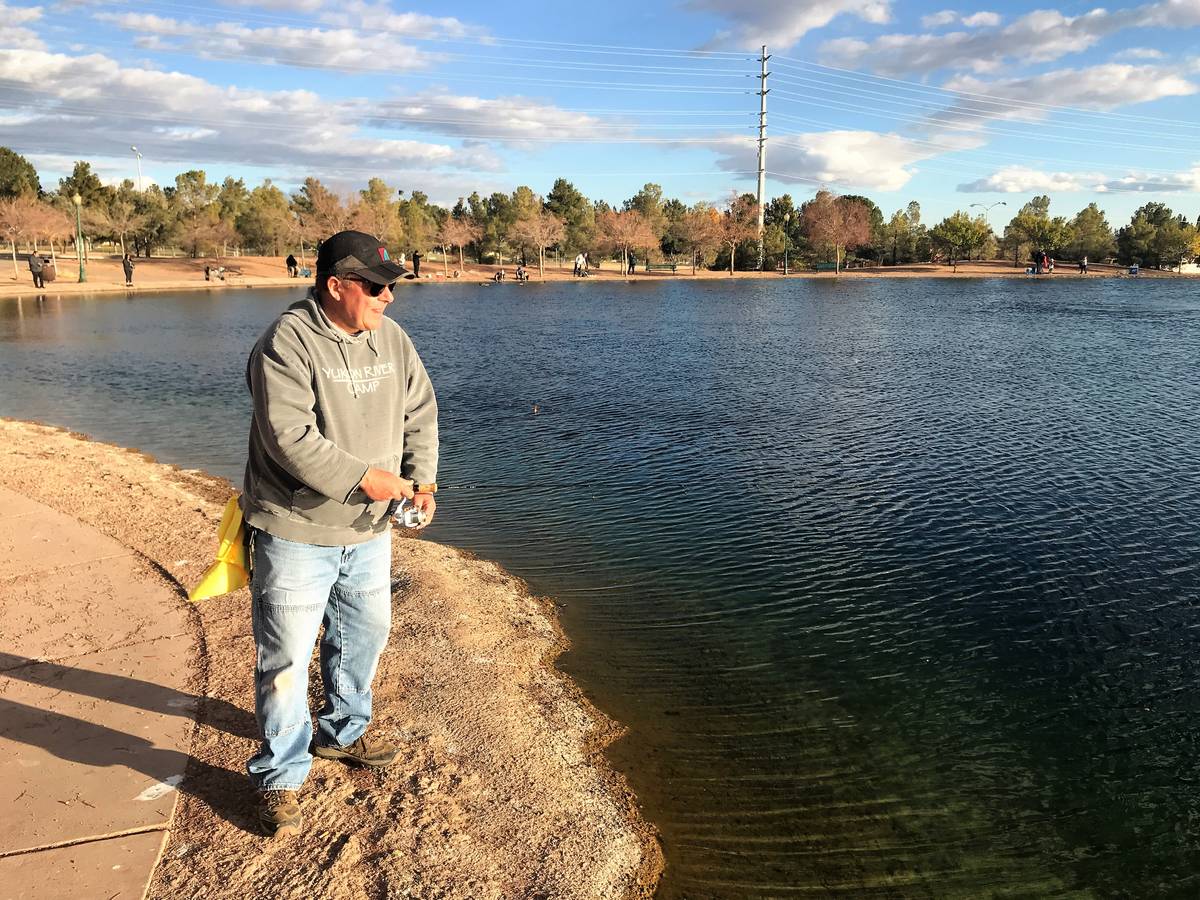Man-made urban fisheries a go-to option during pandemic
As I topped the small rise that marks the southern edge of the upper pond at Veterans Memorial Park in Boulder City, a quick look along the shoreline let me know there were about 30 anglers in various stages of fishing. Some were baiting their hooks, some were casting, some were sharing fishing tales and one or two were reeling in a fish.
Among the group were solo anglers, couples, families with young kids and groups of friends. Some were teenagers and others were far beyond that, their gray hair indicative of years of life experience. And at that moment, they all were sharing an outdoor experience in the middle of an urban environment.
“There hasn’t been any fish on yet today, but like I said, this is so much better than sitting in front of the TV.”
Those are the words of Kurt Asplindh of Las Vegas. Someone whose fishing experience became obvious as soon as we began visiting. Like many anglers he had been introduced to fishing by his father and grandfather.
Hehe grew up fishing for catfish and stripers on the California Delta. Yet there he was standing along the man-made shoreline of what the outdoor industry calls an urban or community fishery, an in-town pond or lake stocked periodically with various species of sportfish.
Wildlife agencies in many states, including Nevada, Arizona and Utah here in the West, have created these fisheries to bring fishing opportunity to city dwellers who might not be able to get to a lake or river outside of town. “If the people can’t get to the fish, we’ll bring the fish to the people,” reads Arizona’s community fishing motto.
For someone with his fishing background, Asplindh might seem out of place at an urban pond, but he doesn’t think so. He just likes being outside.
“I just started discovering these ponds. I mean, I’ve lived here for 15 years. The funny part is that I normally go up to Eagle Valley Reservoir, or I go up to Illipah. I go up north and fish up there. But with everything going on, it’s just been nice discovering the stuff around here,” Asplindh said.
Mike Garcia, of Henderson, has been fishing Southern Nevada’s urban ponds for more than 20 years. He has done so three to four days a week since suffering the effects of a stroke earlier this year. I asked what keeps him coming back.
“The fact that you’ve got nice waters, nice atmosphere, and they stock it yearly. So it’s fun. During the winter months they stock with trout. The summer months they stock with catfish. So it can be all year-round fishing,” Garcia said.
Garcia prefers fly-fishing to fishing with traditional bait methods, because he likes to be actively engaged in the angling process. “But when the flies aren’t working, you go to your old school,” he said.
“I think my go-to is going be the Pistol Pete, or a Woolly Bugger somewhere in size 10 or 12 when it comes to flies. When it comes to bait fishing, I’m not really the kind of person that likes to sit with bait in the water. So I’ll use Power Worms and just kind of jig it or use lures. I think my go-to lure is going to be a Thomas Buoyant. I think that works best out here.”
For Garcia, however, the urban fishing experience is about more than catching fish. The act of fishing became a means of physical therapy. The right-hander taught himself to cast his fly-rod as a lefty but is now getting his strength back on the right side.
“I can actually hold the pole in my right hand and reel in with my left like I used to. So I am getting strength, you know, fighting fish and getting the strength back.”
For Tim, an avid angler from Henderson who preferred not to reveal his last name, the urban fisheries are just enough to meet his fishing need and do not require him to travel far. “I’m retired and this is about as far as I want to go about fishing. Sitting here and enjoying myself. That’s it.”
But don’t mistake Tim’s relaxed approach to mean fishing is no longer important in his life. After all, it is something he has been doing since his grandfather introduced him to the pastime as a child.
“I would probably consider moving if there wasn’t any kind of fishing. It’s a priority,” Tim said. “If there was nothing like this, I’d probably move.”
Freelance writer Doug Nielsen is a conservation educator for the Nevada Department of Wildlife. His “In the Outdoors” column is not affiliated with or endorsed by the NDOW. Any opinions he states in his column are his own. Find him on Facebook at @dougwritesoutdoors. He can be reached at intheoutdoorslv@gmail.com


















